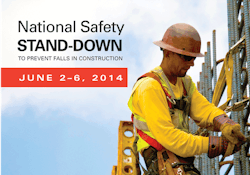A stand-down is a break in the workday to raise awareness of jobsite hazards. OSHA explains that employers can use the time to conduct toolbox talks, equipment inspections, rescue planning or other safety activities.
With the focus on fall prevention this week, OSHA offers the following suggestions for conducting a successful fall prevention stand-down:
- Try to start early. Designate a coordinator to organize the stand-down. If you have multiple worksites, identify the team that will lead the stand-down at each site.
- Consider asking your subcontractors, owner, architects, engineers or others associated with your project to participate in the stand-down.
-
Consider reviewing your fall prevention program. This will help provide a more effective stand-down.
-
What types of falls could happen?
- Falls from ladders
- Falls from a roof
- Falls from a scaffold
- Falls down stairs
- Falls from a structural steel
- Falls through a floor or roof opening
- Falls through a fragile roof surface
- What needs improvement? Is your program meeting its goals? Are you experiencing fatalities, injuries, or near misses? Are employees aware of the company's fall protection procedures?
- What training have you provided to your workers? Does it need revision?
- What equipment have you provided to your workers? Is better equipment available?
-
What types of falls could happen?
- Develop presentations or activities that will meet your needs. Decide what information will be best for your workplace and workers. The meeting should provide information to workers about hazards, protective methods, and the company’s safety policies, goals and expectations. Hands-on exercises (a worksite walkaround, equipment checks, etc.) can increase retention.
- Decide when to hold the stand-down and how long it will last. Decide if the stand-down will take place over a break, a lunch period or some other time.
- Promote the stand-down. Try to make it interesting to workers. Some employers find that serving snacks increases participation.
- Hold your stand-down. Try to make it positive and interactive. Let workers talk about their experiences and encourage them to make suggestions.
- Follow up. If you learned something that could improve your fall prevention program, consider making changes.
About the Author
Sign up for our eNewsletters
Get the latest news and updates
